莎士比亚Sonnet 29 几种译本的批评与赏析
- 格式:ppt
- 大小:1.13 MB
- 文档页数:23
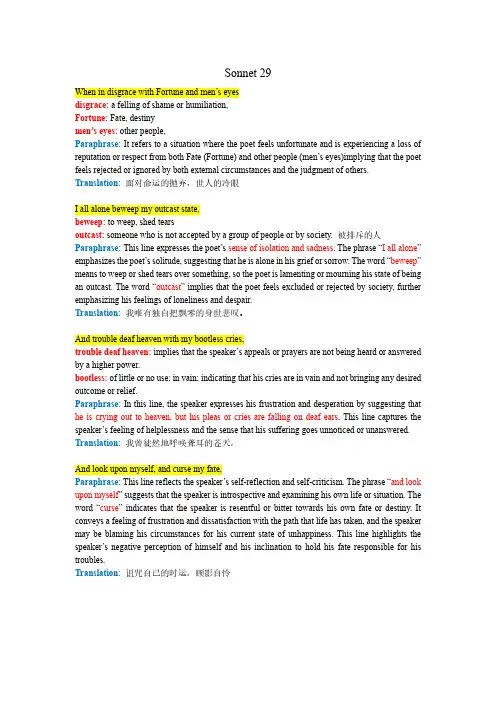
Sonnet 29When in disgrace with Fortune and men’s eyesdisgrace: a felling of shame or humiliation,Fortune:Fate, destinymen’s eyes: other people,Paraphrase: It refers to a situation where the poet feels unfortunate and is experiencing a loss of reputation or respect from both Fate (Fortune) and other people (men’s eyes)implying that the poet feels rejected or ignored by both external circumstances and the judgment of others. Translation: 面对命运的抛弃,世人的冷眼I all alone beweep my outcast state,beweep: to weep, shed tearsoutcast: someone who is not accepted by a group of people or by society. 被排斥的人Paraphrase:This line expresses the poet’s sense of isolation and sadness. The phrase “I all alone” emphasizes the poet’s solitude, suggesting that he is alone in his grief or sorrow. The word “beweep” means to weep or shed tears over something, so the poet is lamenting or mourning his state of being an outcast. The word “outcast” implies that the poet feels excluded or rejected by society, further emphasizing his feelings of loneliness and despair.Translation: 我唯有独自把飘零的身世悲叹。
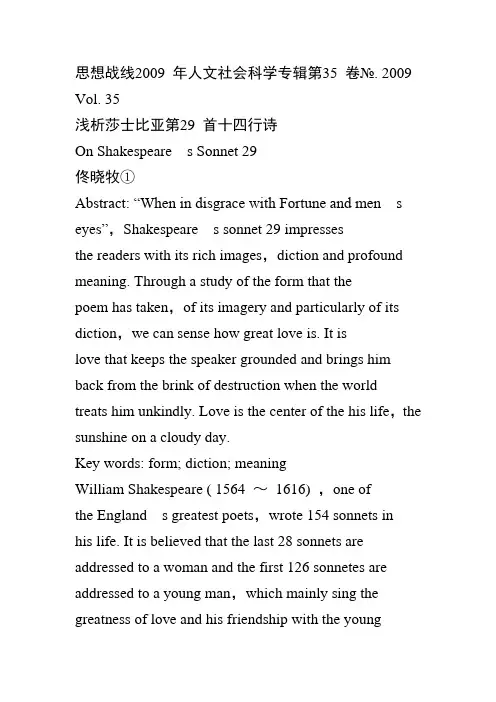
思想战线2009 年人文社会科学专辑第35 卷№. 2009 Vol. 35浅析莎士比亚第29 首十四行诗On Shakespeare s Sonnet 29佟晓牧①Abstract: “When in disgrace with Fortune and men s eyes”,Shakespeare s sonnet 29 impressesthe readers with its rich images,diction and profound meaning. Through a study of the form that thepoem has taken,of its imagery and particularly of its diction,we can sense how great love is. It islove that keeps the speaker grounded and brings him back from the brink of destruction when the world treats him unkindly. Love is the center of the his life,the sunshine on a cloudy day.Key words: form; diction; meaningWilliam Shakespeare ( 1564 ~1616) ,one ofthe England s greatest poets,wrote 154 sonnets inhis life. It is believed that the last 28 sonnets are addressed to a woman and the first 126 sonnetes are addressed to a young man,which mainly sing the greatness of love and his friendship with the youngman. Sonnet 29 is one of them. This sonnet impresses me most with its rich images,diction and profound meaning. Through a study of the form that thepoem has taken,of its imagery and particularly of its diction,we can sense how great the love is. It islove that keeps the speaker grounded and brings him back from the brink of destruction when the world treats him unkindly. Love is the center of the hislife,the sunshine on a cloudy day.Stylistically,it is a typically Shakespearian inits form. It is written in iambic pentameter,usingthe rhyme scheme a b a b,c d c d,e f e f in thefirst twelve lines and then concludes it with a rhyming couplet g g. For this sonnet,the first eightlines,which begins with“when”,establish a conditional argument and show the poet s frustration withhis craft. The third quatrain,beginning with“yet”similar to other sonnets “But”,and resolving the conditional argument,presents a splendid image of a morning lark that“sings hymns at heaven s gate. ”This image epitomizes the poet s delightful memoryof his friendship with the youth and compensates forthe misfortune he has lamented. And then,the ending couplet sums up the meaning of the sonnet. Thisis the convention of logical and rhetorical organization that governs Shakespearian sonnets,namely“a structure of two parts laid over four. The two partsare the three quatrains,on the one hand,and the concluding or revolving couplet,on the other. ”Soin most Shakespearian sonnets,“The turn normally occurs at the beginning of line 13. Each of the quatrains should serve in its own way to complicate the situation or to advance the dilemma which is the couplet s b usiness to resolve. ”It is through the choice of the structure that the poet hints that themost important part of the sonnet is not in his depression and anxiety presented in the quatrains. Instead,it lies in the final independently rhymed couplet,the last two lines which help bring about theturn and also the climax of the poem.While moving from quatrain to quatrain,wemay be also impressed by its rich imagery. The image brought about in lines 9 ~12 are critical pointsin the sonnet as it changes the focus of the sonnet.The first portion of the sonnet focuses on a great dealof challenge and misfortune. Yet,through the invocation of the love subject of the speaker,we begin tosee how the power and redemptive spirit of love canbe transformative. The simile which helps to evokethis would be the use of the bird. When Shakepeare ·37·①作者简介: 佟晓牧,云南大学大学外语教学部讲师( 云南昆明,650091) 。
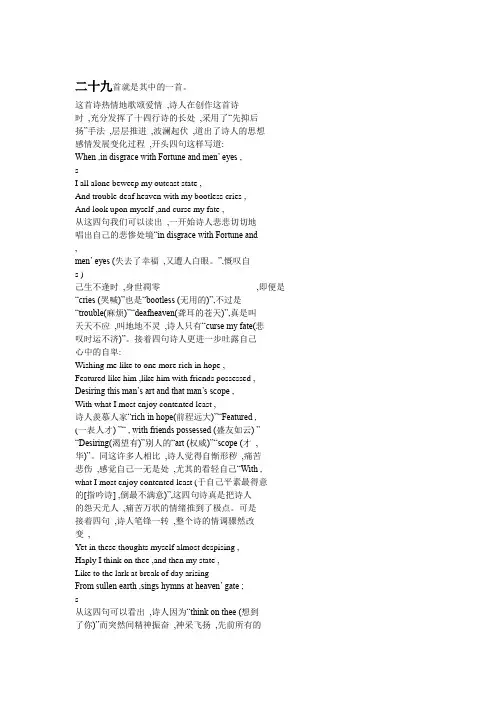
二十九首就是其中的一首。
这首诗热情地歌颂爱情,诗人在创作这首诗时,充分发挥了十四行诗的长处,采用了“先抑后扬”手法,层层推进,波澜起伏,道出了诗人的思想感情发展变化过程,开头四句这样写道:When ,in disgrace with Fortune and men’ eyes ,sI all alone beweep my outcast state ,And trouble deaf heaven with my bootless cries ,And look upon myself ,and curse my fate ,从这四句我们可以读出,一开始诗人悲悲切切地唱出自己的悲惨处境“in disgrace with Fortune and,men’ eyes (失去了幸福,又遭人白眼。
”,慨叹自s )己生不逢时,身世凋零,即便是“cries (哭喊)”也是“bootless (无用的)”,不过是“trouble(麻烦)”“deafheaven(聋耳的苍天)”,真是叫天天不应,叫地地不灵,诗人只有“curse my fate(悲叹时运不济)”。
接着四句诗人更进一步吐露自己心中的自卑:Wishing me like to one more rich in hope ,Featured like him ,like him with friends possessed , Desiring this man’s art and that man’s scope ,With what I most enjoy contented least ,诗人羡慕人家“rich in hope(前程远大)”“Featured ,(一表人才) ”“ , with friends possessed (盛友如云) ” “Desiring(渴望有)”别人的“art (权威)”“scope (才, 华)”。
同这许多人相比,诗人觉得自惭形秽,痛苦悲伤,感觉自己一无是处,尤其的看轻自己“With , what I most enjoy contented least (于自己平素最得意的[指吟诗] ,倒最不满意)”,这四句诗真是把诗人的怨天尤人,痛苦万状的情绪推到了极点。
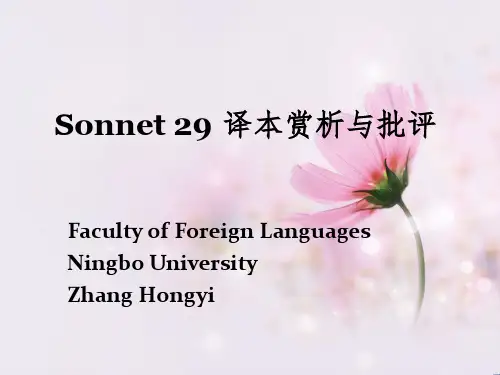
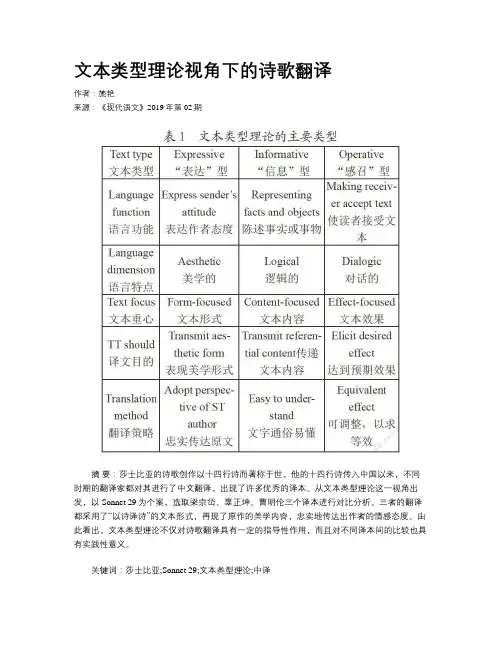
文本类型理论视角下的诗歌翻译作者:施艳来源:《现代语文》2019年第02期摘要:莎士比亚的诗歌创作以十四行诗而著称于世。
他的十四行诗传入中国以来,不同时期的翻译家都对其进行了中文翻译,出现了许多优秀的译本。
从文本类型理论这一视角出发,以Sonnet 29为个案,选取梁宗岱、辜正坤、曹明伦三个译本进行对比分析。
三者的翻译都采用了“以诗译诗”的文本形式,再现了原作的美学内容,忠实地传达出作者的情感态度。
由此看出,文本类型理论不仅对诗歌翻译具有一定的指导性作用,而且对不同译本间的比较也具有实践性意义。
关键词:莎士比亚;Sonnet 29;文本类型理论;中译莎士比亚不仅是享誉世界的戏剧家,也是一位出色的诗人。
他的诗歌创作以十四行诗而著称于世。
莎士比亚的十四行诗[1]以歌颂友谊和爱情为主要内容。
第29首十四行诗就是一首经典之作。
此诗记录了诗人从消极到振奋、从忧郁到欢喜、从自卑到自豪的心路变化历程,讴歌了友谊的崇高与伟大,宣扬了真、善、美的和谐统一,从中传达出深沉热烈的爱的理念。
阅读莎士比亚的十四行诗,不仅使读者陶醉于其优美的诗句,更让人为他自然真诚的友情所感动,因此传遍了世界各地。
中国也出现了许多关于该诗的翻译版本,其中梁宗岱的中译本(以下简称梁译)[2]、辜正坤的中译本(以下简称辜译)[3]与曹明伦的中译本(以下简称曹译)[4]尤为出色。
本文拟从文本类型的角度出发,选取梁宗岱、辜正坤与曹明伦的译本进行比较分析,主要目的不在于阐述三个中译本的孰优孰劣,而在于探讨诗歌翻译的文体、策略和方法与文本类型理论的互动关系。
一、文本类型理论诗歌之所以难于翻译,归根到底,是因为它是一种特殊的文学形式。
优秀的诗歌通常具有丰富的思想内涵、优雅的语言形式。
在语际相互转换过程中,语言形式与文本内容之间往往会产生不容忽视的冲突,译者很难完全兼顾这两个方面。
因此,有翻译家说:“Traduttori traditori (翻译就是背叛)”[5](P140)。
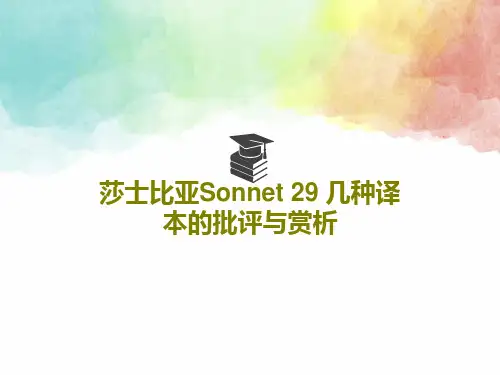
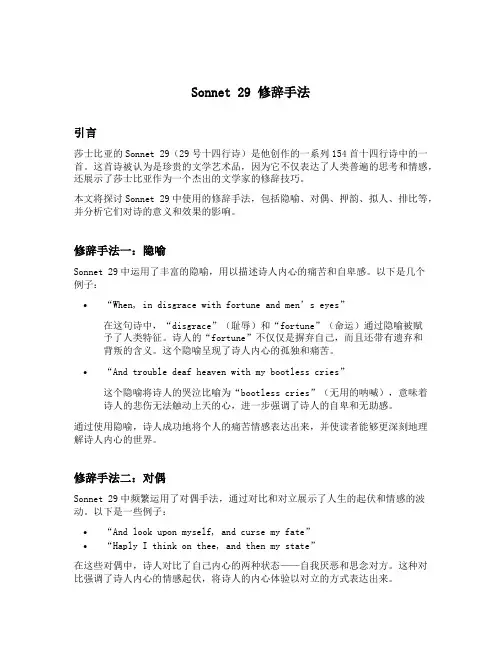
Sonnet 29 修辞手法引言莎士比亚的Sonnet 29(29号十四行诗)是他创作的一系列154首十四行诗中的一首。
这首诗被认为是珍贵的文学艺术品,因为它不仅表达了人类普遍的思考和情感,还展示了莎士比亚作为一个杰出的文学家的修辞技巧。
本文将探讨Sonnet 29中使用的修辞手法,包括隐喻、对偶、押韵、拟人、排比等,并分析它们对诗的意义和效果的影响。
修辞手法一:隐喻Sonnet 29中运用了丰富的隐喻,用以描述诗人内心的痛苦和自卑感。
以下是几个例子:•“When, in disgrace with fortune and men’s eyes”在这句诗中,“disgrace”(耻辱)和“fortune”(命运)通过隐喻被赋予了人类特征。
诗人的“fortune”不仅仅是摒弃自己,而且还带有遗弃和背叛的含义。
这个隐喻呈现了诗人内心的孤独和痛苦。
•“And trouble deaf heaven with my bootless cries”这个隐喻将诗人的哭泣比喻为“bootless cries”(无用的呐喊),意味着诗人的悲伤无法触动上天的心,进一步强调了诗人的自卑和无助感。
通过使用隐喻,诗人成功地将个人的痛苦情感表达出来,并使读者能够更深刻地理解诗人内心的世界。
修辞手法二:对偶Sonnet 29中频繁运用了对偶手法,通过对比和对立展示了人生的起伏和情感的波动。
以下是一些例子:•“And look upon myself, and curse my fate”•“Haply I think on thee, and then my state”在这些对偶中,诗人对比了自己内心的两种状态——自我厌恶和思念对方。
这种对比强调了诗人内心的情感起伏,将诗人的内心体验以对立的方式表达出来。
另一个例子是以下对偶:•“Yet in these thoughts myself almost despising”•“Haply I think on thee, and then my state”这个对偶表达了诗人内心的矛盾情感。

二十九首就是其中的一首。
这首诗热情地歌颂爱情,诗人在创作这首诗时,充分发挥了十四行诗的长处,采用了“先抑后扬”手法,层层推进,波澜起伏,道出了诗人的思想感情发展变化过程,开头四句这样写道:When ,in disgrace with Fortune and men’ eyes ,sI all alone beweep my outcast state ,And trouble deaf heaven with my bootless cries ,And look upon myself ,and curse my fate ,从这四句我们可以读出,一开始诗人悲悲切切地唱出自己的悲惨处境“in disgrace with Fortune and,men’ eyes (失去了幸福,又遭人白眼。
”,慨叹自s )己生不逢时,身世凋零,即便是“cries (哭喊)”也是“bootless (无用的)”,不过是“trouble(麻烦)”“deafheaven(聋耳的苍天)”,真是叫天天不应,叫地地不灵,诗人只有“curse my fate(悲叹时运不济)”。
接着四句诗人更进一步吐露自己心中的自卑:Wishing me like to one more rich in hope ,Featured like him ,like him with friends possessed , Desiring this man’s art and that man’s scope ,With what I most enjoy contented least ,诗人羡慕人家“rich in hope(前程远大)”“Featured ,(一表人才) ”“ , with friends possessed (盛友如云) ” “Desiring(渴望有)”别人的“art (权威)”“scope (才, 华)”。
同这许多人相比,诗人觉得自惭形秽,痛苦悲伤,感觉自己一无是处,尤其的看轻自己“With , what I most enjoy contented least (于自己平素最得意的[指吟诗] ,倒最不满意)”,这四句诗真是把诗人的怨天尤人,痛苦万状的情绪推到了极点。
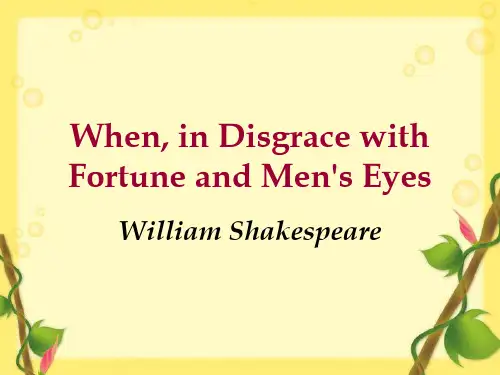

18莎士比亚的十四行诗总体上表现了一个思想:爱征服一切。
他的诗充分肯定了人的价值、赞颂了人的尊严、个人的理性作用。
诗人将抽象的概念转化成具体的形象,用可感可见的物质世界,形象生动地阐释了人文主义的命题。
诗的开头将“你〞和夏天相比较。
自然界的夏天正处在绿的世界中,万物繁茂地生长着,繁阴遮地,是自然界的生命最昌盛的时刻。
那醉人的绿与鲜艳的花一道,将夏天打扮得五彩缤纷、艳丽动人。
但是,“你〞却比夏天可爱多了,比夏天还要温婉。
五月的狂风会作践那可爱的景色,夏天的期限太短,阳光酷热地照射在繁阴班驳的大地上,那熠熠生辉的美丽不免要在时间的流动中凋残。
这自然界最美的季节和“你〞相比也要逊色不少。
而“你〞能克服这些自然界的不足。
“你〞在最灿烂的季节不会凋谢,甚至“你〞美的任何东西都不会有所损失。
“你〞是人世的永恒,“你〞会让死神的黑影在遥远的地方停留,任由死神的夸口也不会死去。
“你〞是什么?“你〞与人类同在,你在时间的长河里不朽。
那人类精神的精华——诗,是你的形体吗?或者,你就是诗的精神,就是人类的灵魂。
诗歌在形式上一改传统的意大利十四行诗四四三三体,而是采用了四四四二体:在前面充分地发挥表达的层次,在充分的铺垫之后,用两句诗结束全诗,点明主题。
全诗用新颖巧妙的比喻,华美而恰当的修饰使人物形象鲜明、生气鲜活。
诗人用形象的表达使严谨的逻辑推理变得生动有趣、曲折跌宕,最终巧妙地得出了人文主义的结论。
二十九首就是其中的一首。
这首诗热情地歌颂爱情,诗人在创作这首诗时,充分发挥了十四行诗的长处,采用了“先抑后扬〞手法,层层推进,波澜起伏,道出了诗人的思想感情发展变化过程,开头四句这样写道:When ,in disgrace with Fortune and men’ eyes ,sI all alone beweep my outcast state ,And trouble deaf heaven with my bootless cries ,And look upon myself ,and curse my fate ,从这四句我们可以读出,一开始诗人悲悲切切地唱出自己的悲惨处境“in disgrace with Fortune and,men’ eyes (失去了幸福,又遭人白眼。
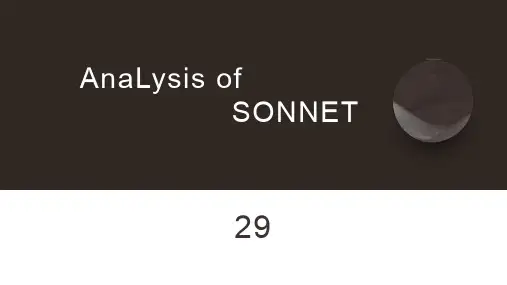
Comparison of Chinese Translations of
Shakespeare’s Sonnet 29
作者: 荣钰[1]
作者机构: [1]上海理工大学外语学院,上海200093
出版物刊名: 上海理工大学学报:社会科学版
页码: 331-337页
年卷期: 2019年 第4期
主题词: 莎士比亚;第29首十四行诗;汉译对比
摘要:莎士比亚不仅是英国文学史上伟大的戏剧家,也是一位极具创造力的诗人,他创作的十四行诗语言运用巧妙、韵律节奏优美,对世界各地的读者都有着巨大的吸引力。
其中,第29首十四行诗运用奇特构思、惊人妙语真实地展现了诗人的心路变化历程,吸引了中国众多翻译名家对其进行汉译尝试,有4种汉译本颇具代表性。
通过对这4种语言各具风格,韵律各含特色的汉译本进行对比分析,旨在向先辈时贤的研究心血致敬的同时,尝试探寻更符合现代审美的译文,以期为今后莎士比亚十四行诗的汉译提供些许参考。
莎士比亚第29首十四行诗的欲望赏析
邓飞
【期刊名称】《四川文理学院学报》
【年(卷),期】2010(20)6
【摘要】从欲望角度分析了莎士比亚第29首十四行诗中的食欲、情欲和权欲,指出食欲是最基本的欲望,情欲自身潜在着二重性以及权欲的危害性,并提出了处理欲望的最佳办法.
【总页数】3页(P60-62)
【作者】邓飞
【作者单位】四川文理学院,外语系,四川,达州,635000
【正文语种】中文
【中图分类】I106.2
【相关文献】
1.爱与痛的边缘——莎士比亚十四行诗赏析 [J], 石亮;
2.爱与痛的边缘——莎士比亚十四行诗赏析 [J], 石亮
3.莎士比亚第十八首十四行诗的形式主义赏析 [J], 白雪
4.纵帝王屈尊就我,不与换江山——莎士比亚第29首十四行诗赏析 [J], 卢小军
5.莎士比亚第十八首十四行诗的形式主义赏析(英文) [J], 白雪
因版权原因,仅展示原文概要,查看原文内容请购买。